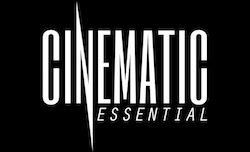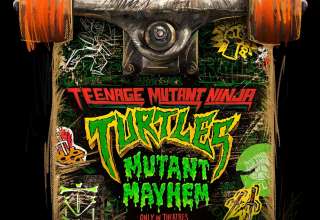You may not know much about Jeremy Saulnier at this exact moment, but you’re going to start as he’s being considered as an up and coming filmmaker with some serious potential. The critically acclaimed Blue Ruin captured the attention of many after its release back in 2014, but that’s looking like only the beginning. The release of Green Room represents another step in that process as it’s the biggest movie of his short career. When speaking to him, I found him to be passionate about not only that, but also the practice of filmmaking and all that comes with it.
Cinematic Essential: Why violence? What interest you about it?
Jeremy Saulnier: It’s not so much the violence as it is the threat of violence. I just gravitate towards intense storytelling. From an audience perspective, I just like to be excited. And I find as I get a little older and I have such a rich experience with my family, violent filmmaking is a good outlet. And it’s not so much to examine the loss of life. It’s to heighten the stakes and to give myself the opportunity for choreography and special effects makeup and fast moving cameras and objects that collide. It’s just more exciting, period. It doesn’t always have to involve death, but so far it’s worked out pretty well and I’m examining it, I’m troubled by it and I’m excited by it at the same time. It just makes for the high impact cinema that I’m innately attracted to.
What lead you to want to make a film with a group of neo-Nazis as your antagonists?
We would drive across the bridge from Alexandria (in Virginia) into Washington D.C. We were hardcore punk kids, but we weren’t familiar with the real scene, the birthplace of hardcore and a vibrant punk environment. In the 90’s, most of the big shows would have at least a few nazi skinheads, which was surreal. You see people proudly wearing swastikas at shows and they would attract violence. Most often in D.C. they were the victims, because they weren’t the majority at these shows, but they were there and there would be fights. And there were some bands that I f*cking loved their music. And some of them, you would read some of the liner notes and they were f*cking leading white power. There’s something about it that attracts vegans, nazis, Hare Krishnas. This was a huge umbrella for so many subcultures within a subculture. The nazis stood out not because of their ideologies, but because they wore uniforms. They were soldiers, they wanted to be separate. They had different structures and almost a gang affiliation.
That just stuck with me. I went in and out of the hardcore scene from Washington D.C. and I went to college in New York where I got more into b-boying and hip-hop for a bit. But I realized that all the scenes are kind of the same. There are people who want to regulate it and preach and teach about history and people like me who are just attracted to it for the physicality. For the hip-hop scene, I was more into the b-boying because it’s a physical expression. That’s why I loved skateboarding as a kid and why I loved hardcore music as a teenager.
So then I get through college and I’m trying to work and I’m obsessed with trying to become a filmmaker and I’m getting softer, I’m having kids, I’m a family man. And I realize that all of this history is not archived. It’s pre-internet and I’m just a square on the street buying a f*cking croissant. It’s lame. So when the opportunity arose to make another movie after Blue Ruin, I kind of was like, “Well, sh*t. I have this history in the hardcore scene. I know it well. I lived it and I can use it for this idea which had been floating around. The idea for Green Room actually predates Blue Ruin, but I just didn’t have access to a club or the resources to make that movie. So as soon as Blue Ruin did well I was like, “F*ck it, I’m making Green Room. I know I shouldn’t, I should make some bigger, classier studio film,” but this is a film where I was actually the caretaker and can make this insane movie that I generally felt no one else could make at that time. Then once I had the things in place, I knew the world it was set in, I knew the general premise of the situation backstage. And then it was all brand new and became exciting all over again. It seemed like it was this inevitable thing and it offered me closure after 20 years by having this history that I could finally archive, put it on screen and put it to bed.
The antagonists seem more authentic than a lot of the skinheads you see in film. How much research went into getting that right?
The key was to do a ton of research to just feel like I got a sense of the vernacular, the procedures, the structure and the customs, and then throw it all away. Let the characters take the foreground. The challenge is not portraying nazi skinheads as bad guys. The challenge is portraying them as humans. The whole thing is about whatever we come in with as far as the perceived gangs or affiliations or ideologies or labels, the film strips that away eventually. So it’s to immerse yourself into the world and have it seem authentic, then have it all drift away. The research was kind of brutal. I was researching Nazis, skinheads, this sort of white supremacist culture, dog fighting, dog attacks. I was definitely losing my stomach for this film as I was making it. I’m huge on research. I inject just enough detail to make it authentic to the characters. The rule is they have totally amongst themselves and never to the audience. You get insight into a culture, but you don’t get a tour. You kind of let it unfold naturally.
What about how the film is set up? It’s not always conventional here in terms of character arcs and structure.
All I do is set the stage and let it play out as I think it should in a more authentic way. That inevitably pumps up against convention. It’s not that I’m not aware of it, but I try to disregard it. Once in a while, I’ll do a little nod but it always has to have a real motivation. There’s a part in Green Room where there’s a typical speech that starts to evolve, then there’s just no time, so that person is cutoff and they just keep going. When those things line up, I let it happen. It’s fun, but I never intend it to be false or contrived. Films are sometimes prepackaged and people who should know otherwise tend toward safety and familiarity. They want to recycle the same plot or they’re like, “Oh, you need a character arc here,” but why? Would the person here actually start talking about their past? Would that be native to the environment? The answers usually, no. How can we build characters without having to force them to do things that seemed very much contrived and think of the audience and not themselves. Again, there’s some exposition in Green Room, but it takes place during an interview. It’s very much motivated. They’re talking about themselves and why they’re there, but other than that you just have to go along with the ride. I won’t allow the characters to explain it all.
When creating a story, do you start with political issues or personal issues?
Anything political kind of seeps in, but I really start off with a premise and just try to examine it. I think with Blue Ruin, it’s more of a purposive motivation and traditional mission that we’ve seen a thousand times. I just wanted to explore a personal version of what might happen if anyone would indulge and embark on a revenge mission. I think it would be very difficult. And just how messy things get. I love minutiae and things that are often disregarded in bigger action movies. In Green Room too, it’s information depravation and very specific procedural details on what’s happening, but the terror is that you’re watching it unfold and the people outside this room know what they’re doing. It’s brutal and hard to experience in the moment. Only later do you realize that it’s pragmatic. It’s not a sadistic bloodlust that they’re trying to fulfill. It’s just a mop up operation. So, it’s fun just not adhering to structure and formula when you don’t have to. I do very simple movies. Blunt force movies. By trusting the audience to fill in the gaps to create more of an experience and less of a lecture it becomes very fulfilling for people to get to see relatable characters onscreen behaving like humans. That includes f*cking up miserably.
How have you dealt with casting so far in our career?
I don’t know who anyone is. I just cast on the merits of their craft. I meet people if they’re willing to go on tape and they’re we just see who the best fit is, which is a rare experience. I get to cast whoever I want. When you’re with people with a little more star power and they happen to be great actors, that’s great, but if they’re not enthusiastic about the material or don’t want to be there and show a certain amount of investment, then they’re not welcome. Not because I don’t want them. It’s because when you’re building a cast and you’re making a movie, everyone is so very vulnerable and the collective energy is such an important thing.
What was your experience working on Green Room when compared to Blue Ruin?
They’re so different. Blue Ruin was all homegrown. Available resources, my best buddy (Macon Blair) as the actor. I knew all of the variables going in and I just wrote it into the script, so there was like zero translation problems. I knew it all. I had diagrams the I wrote for the locations. Green Room is completely built from scratch. That whole venue was a set built on a sound stage. I never had the opportunity to do world building before or even work on a sound stage in a contained, controlled environment. So, as I leap from film to film, the learning curve is still huge. I don’t even know how that will apply to my next film, but I hope in the near future to stabilize and enjoy the process a little more. Right now, I can’t believe the run after Blue Ruin. I can’t believe I get to make movies and have access to scripts and actors. The meetings I’ve been having the last couple of months have been insane and I’m still terrified. From the indy film world, you never trust your environment. The key is too enjoy it more, but not lose the nervous energy I have to really preserve what ever intention I have artistically.
Do you see yourself making bigger films in the future?
I would totally do a big studio movie if it’s the right fit and I would totally retreat back into the woods and make a little indy with my friends.
What’s the right fit?
Meaning just creatively. If I like it and feel like I want to do two years doing it, but I eventually want to expand and do types of films that may be a little less brutal than Green Room the next time. Maybe more. Who knows, but I do want to make a film that my mom can watch with her friends. One day make one that my daughters can watch. I may just wait for them to turn 18.



























